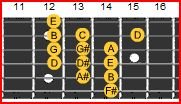The Chromatic Scale: To Infinity and beyondHey there! Guitarslinger here. This next lesson is a conceptual lesson and is meant to show you what the Chromatic scale is and how to apply it to metal or rock soloing and riffing. I would hope that you have already read my previous "Art of Shredding" lessons before you read this one. The Chromatic scale is a scale which divides an entire octave into its semitones. In one octave there are twelve semitones (or thirteen if you count the root note twice), or half notes. Here is an example of the Chromatic scale:
As you can see the notes in the scale are C C# D D# E F F# G G# A A# B and C. Playing in successive half steps is called playing chromatically, hence the name Chromatic scale. The Chromatic scale is the mother of all other scales and chords in western music. The Chromatic scale can be a tough concept for some guitarists out there, even some who can already shred have no clue how apply the scale. Application I like to think of the Chromatic scale as a tool used to enhance other scales by throwing in chromatic tones here and there. If you think about it, you play chromatics more often than you may realize. Take the A minor blues scale:
There are many other scales with chromatic quatlities but I think a more practicle way to understand how to apply the Chromatic scale would be to give of example of how I use it. So I came up with a very simple two chord chromatic riff and played three main scale patterns in which I employ chromatic elements. Here are the scale patterns: As you can see, this pattern consists of the notes E G# A A# B C C# & D. The are Chromatic tones from G# all the way to D:  In this next pattern I play G A B C D E F & F#. You can think of this pattern as G Ionian which has the notes: G A B C D E & F#. However, I had E Aeolian in mind, which is in the key of G major, but I added the F from the A Aeolian scale (A B C D E F G)To play in conjunction with the F5 in the rhyrhm riff:  The last main pattern I used is also very chromatic:  Moving on, here is the tune. Like any solo finger position is important here.
Ok, that's all for now. I hope I've helped a bit. I know I used to have trouble with the concept of the applying the Chromatic scale, but playing stuff like this is what helped me to understand it better. Rock on enjoy!
Comments:
01
06.14.2009  carlsnow carlsnow
nice lesson(s), Guitarslinger124 !!!
02
06.14.2009  Guitarslinger124 Guitarslinger124
Hey man, all you do to insert a tab is to type [tab] before your intended tab and [/tab] afterwards. and wala! Tab you shall have.
03
06.14.2009  Phip Phip
Guitarslinger,
04
06.16.2009  Guitarslinger124 Guitarslinger124
I'm not using any program. I type up my tabs myself. It's a pain in the ass, but that's how I do it. |


